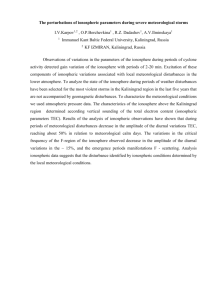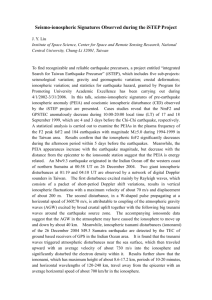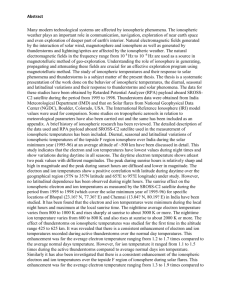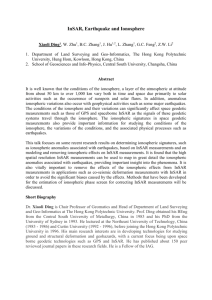Blaunshtein, N.Sh., Vas`kov, VV, Dimant, Ya.S. Resonance heating
advertisement
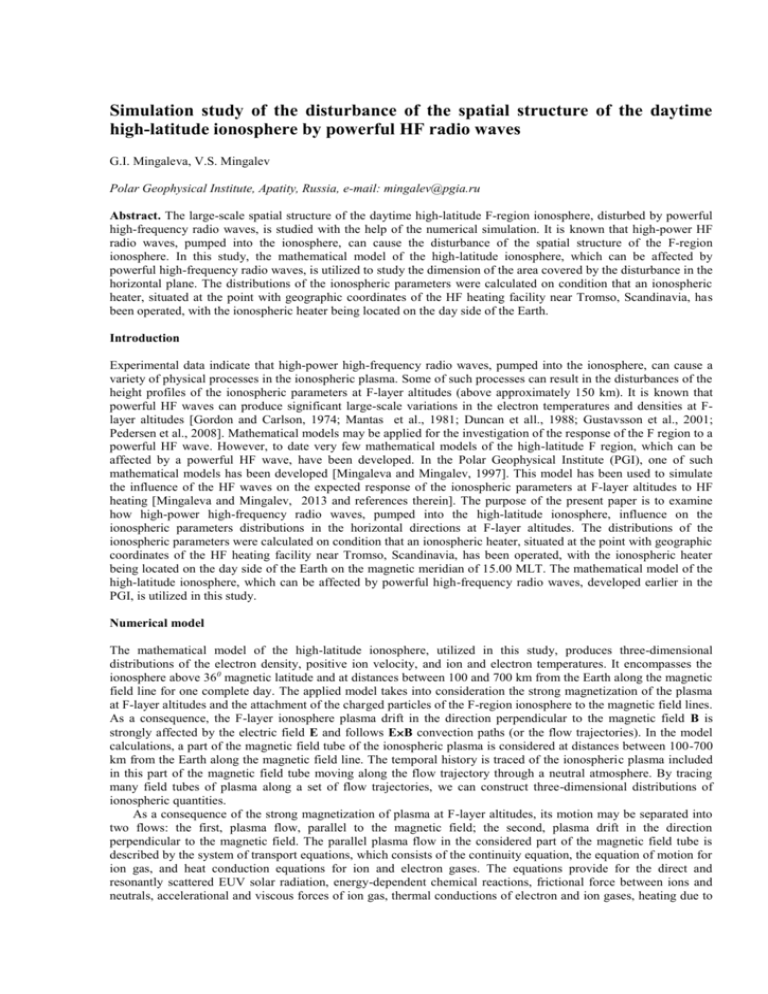
Simulation study of the disturbance of the spatial structure of the daytime high-latitude ionosphere by powerful HF radio waves G.I. Mingaleva, V.S. Mingalev Polar Geophysical Institute, Apatity, Russia, e-mail: mingalev@pgia.ru Abstract. The large-scale spatial structure of the daytime high-latitude F-region ionosphere, disturbed by powerful high-frequency radio waves, is studied with the help of the numerical simulation. It is known that high-power HF radio waves, pumped into the ionosphere, can cause the disturbance of the spatial structure of the F-region ionosphere. In this study, the mathematical model of the high-latitude ionosphere, which can be affected by powerful high-frequency radio waves, is utilized to study the dimension of the area covered by the disturbance in the horizontal plane. The distributions of the ionospheric parameters were calculated on condition that an ionospheric heater, situated at the point with geographic coordinates of the HF heating facility near Tromso, Scandinavia, has been operated, with the ionospheric heater being located on the day side of the Earth. Introduction Experimental data indicate that high-power high-frequency radio waves, pumped into the ionosphere, can cause a variety of physical processes in the ionospheric plasma. Some of such processes can result in the disturbances of the height profiles of the ionospheric parameters at F-layer altitudes (above approximately 150 km). It is known that powerful HF waves can produce significant large-scale variations in the electron temperatures and densities at Flayer altitudes [Gordon and Carlson, 1974; Mantas et al., 1981; Duncan et all., 1988; Gustavsson et al., 2001; Pedersen et al., 2008]. Mathematical models may be applied for the investigation of the response of the F region to a powerful HF wave. However, to date very few mathematical models of the high-latitude F region, which can be affected by a powerful HF wave, have been developed. In the Polar Geophysical Institute (PGI), one of such mathematical models has been developed [Mingaleva and Mingalev, 1997]. This model has been used to simulate the influence of the HF waves on the expected response of the ionospheric parameters at F-layer altitudes to HF heating [Mingaleva and Mingalev, 2013 and references therein]. The purpose of the present paper is to examine how high-power high-frequency radio waves, pumped into the high-latitude ionosphere, influence on the ionospheric parameters distributions in the horizontal directions at F-layer altitudes. The distributions of the ionospheric parameters were calculated on condition that an ionospheric heater, situated at the point with geographic coordinates of the HF heating facility near Tromso, Scandinavia, has been operated, with the ionospheric heater being located on the day side of the Earth on the magnetic meridian of 15.00 MLT. The mathematical model of the high-latitude ionosphere, which can be affected by powerful high-frequency radio waves, developed earlier in the PGI, is utilized in this study. Numerical model The mathematical model of the high-latitude ionosphere, utilized in this study, produces three-dimensional distributions of the electron density, positive ion velocity, and ion and electron temperatures. It encompasses the ionosphere above 360 magnetic latitude and at distances between 100 and 700 km from the Earth along the magnetic field line for one complete day. The applied model takes into consideration the strong magnetization of the plasma at F-layer altitudes and the attachment of the charged particles of the F-region ionosphere to the magnetic field lines. As a consequence, the F-layer ionosphere plasma drift in the direction perpendicular to the magnetic field B is strongly affected by the electric field E and follows EB convection paths (or the flow trajectories). In the model calculations, a part of the magnetic field tube of the ionospheric plasma is considered at distances between 100-700 km from the Earth along the magnetic field line. The temporal history is traced of the ionospheric plasma included in this part of the magnetic field tube moving along the flow trajectory through a neutral atmosphere. By tracing many field tubes of plasma along a set of flow trajectories, we can construct three-dimensional distributions of ionospheric quantities. As a consequence of the strong magnetization of plasma at F-layer altitudes, its motion may be separated into two flows: the first, plasma flow, parallel to the magnetic field; the second, plasma drift in the direction perpendicular to the magnetic field. The parallel plasma flow in the considered part of the magnetic field tube is described by the system of transport equations, which consists of the continuity equation, the equation of motion for ion gas, and heat conduction equations for ion and electron gases. The equations provide for the direct and resonantly scattered EUV solar radiation, energy-dependent chemical reactions, frictional force between ions and neutrals, accelerational and viscous forces of ion gas, thermal conductions of electron and ion gases, heating due to ion-neutral friction, Joule heating, heating due to solar EUV photons, heating caused by the action of the powerful HF radio waves, and electron energy losses due to elastic and inelastic collisions. The applied mathematical model takes into account the heating mechanism, caused by the action of the powerful HF radio waves and connected with the formation of short-scale field-aligned plasma irregularities in the electron hybrid resonance region. These irregularities are responsible for the anomalous absorption of the electromagnetic heating wave passing through the instability region and cause anomalous heating of the plasma. The rate of this anomalous heating is taken from the study by Blaunshtein et al. [1992]. In the present study, the electric field distribution, which is the combination of the pattern B of the empirical models of high-latitude electric fields of Heppner [1977] and the empirical model of ionospheric electric fields at middle latitudes, developed by Richmond et al. [1980], is utilized. The utilized electric field distribution is a steady non-substorm convection model. Using this convection model, we calculate the plasma drift velocity along the convection trajectories, which intersect the F-layer volume illuminated by an ionospheric heater situated at the point with geographic coordinates of the HF heating facility near Tromso, Scandinavia. For these convection trajectories, we obtain variations of profiles against distance from the Earth along the geomagnetic field line of the ionospheric quantities with time (along the trajectory) by solving the system of transport equations. These profiles may be used for the construction of two-dimensional distributions of ionospheric quantities along the each flow trajectory. By taking a set of flow trajectories and using these two-dimensional distributions along the each convection trajectory, we can construct three-dimensional distributions of ionospheric quantities, modified by the action of the ionospheric heater. In this study, the spatial configuration of the electron and proton precipitation zones as well as intensities and average energies of the precipitating electrons and protons were chosen as consistent with the statistical model of Hardy et al. [1989]. The numerical method, boundary conditions, neutral atmosphere composition, thermospheric wind pattern, and input parameters of the model were in detail described in the studies by Mingaleva and Mingalev [1996, 1997, and 1998]. Simulation results Different combinations of the solar cycle, geomagnetic activity level, and season may be described by the utilized mathematical model. In the present study, the calculations are performed for autumn (5 November) and not high solar activity conditions (F10.7 =110) under low geomagnetic activity (Kp=0). In the present study, the calculations were made for two distinct cases. For the first case, we simulated the distributions of the ionospheric parameters under natural conditions without a powerful highfrequency wave effect. For the second case, the distributions of the ionospheric parameters were calculated on condition that an ionospheric heater, situated at the point with geographic coordinates of the HF heating facility near Tromso, Scandinavia, has been operated, with the ionospheric heater being located on the day side of the Earth on the magnetic meridian of 15.00 MLT. For the second case, firstly, we made a series of calculations to choose the wave frequency which provides the maximal effect of HF heating on the electron concentration at the levels near to the F2-layer peak, that is, the most effective frequency for the large-scale F2-layer modification, feff, [Mingaleva and Mingalev, 2013]. It was found that this most effective frequency is 4.9 MHz on condition that the maximal value of the effective absorbed power (EAP) is equal Fig.1. Profiles of the electron to 30 MW which is quite attainable for the heating facility near concentration versus distance from the Tromso. Earth along the geomagnetic field line, Secondly, calculations were carried out, using the pointed out situated in the illuminated region, values of the feff and EAP, to study how the HF radio waves affect the obtained under natural conditions large-scale high-latitude F-layer modification. The ionospheric heater without artificial heating (marked by the was supposed to operate during the period of 435 seconds. symbol ○ ) and disturbed by the heater The results of simulations are partly presented in Figs. 1-3. at the moment of 435 seconds after turn Simulation results indicate that a great energy input from the powerful HF wave arises at the level, where the wave frequency is close to the on (marked by the symbol *). frequency of the electron hybrid resonance, when the ionospheric heater is turned on and operates. At this level, pronounced peak arises in the electron temperature profile. At this peak, the electron temperature can increase for some thousands of degrees. The increase in the electron temperature results in a visible decrease in the electron concentration profile at the levels near to the F2-layer peak (Fig. 1). In particular, the powerful HF waves lead to the decrease of 24% in electron concentration at the level of the F2-layer peak. After turning off of the heater, the electron temperature decreases due to elastic and inelastic collisions between electrons and other particles of ionospheric plasma, and a period of recovery comes. Fig.2. Simulated distributions of the electron concentration (in units of 1011 m-3) at level of 280 km obtained under natural conditions without artificial heating (top panel) and obtained on condition that the ionospheric heater has been operated during the period of approximately seven minutes (bottom panel). The electron concentration cavity, created artificially, is indicated by black pointer at the bottom panel. Fig.3. Simulated distributions of the electron concentration (in units of 1011 m-3) in the magnetic meridian plane, lying across the ionospheric heater, obtained under natural conditions without artificial heating (top panel) and obtained on condition that the ionospheric heater has been operated during the period of approximately seven minutes (bottom panel). The location of the heater is indicated by the black pointer at the bottom panel. In the model calculations, it was assumed that the ionospheric heater provides a beam width of 14.5o (such as the beam width of the ionospheric high-frequency heating facility near Tromce, Scandinavia). Therefore, the diameter of the illuminated region is approximately 88 km at 300 km altitude. As a consequence of the convection of the ionospheric plasma at F-layer altitudes, the volume of plasma, disturbed by a powerful HF wave, can abandon the region illuminated by an ionospheric heater. Therefore, the horizontal section of disturbed region at F-layer altitudes can differ from the horizontal section of the region illuminated by the heater. Let us consider the simulated spatial distributions of the ionospheric parameters. These distributions are presented in Figs. 2 and 3. The simulation results, obtained under natural conditions without artificial heating, contain various large-scale inhomogeneous structures characteristic for the high-latitude ionosphere. The electron concentration distributions contain the well-known tongue of ionization, extended from the local noon side of the Earth across the polar cap to the night side, as well as the main ionospheric trough on the night side of the Earth (Fig. 2). The simulation results, obtained on condition that the ionospheric heater has been operated during the period of 435 seconds, indicate that the electron concentration cavity is formed on the day side in the vicinity of the location of the ionospheric heater (Figs. 2 and 3). Inside this cavity, powerful HF waves lead to a decrease of about 20% in the electron concentration at the level of the F2-layer peak. The simulation results indicate that the cross sections of the artificial electron concentration cavity have dimensions of about 100-150 km in the horizontal directions at the levels of the F layer (Figs. 2 and 3). These dimensions do not coincide with the horizontal section of the region, illuminated by the heater, due to the convection of the ionospheric plasma. It is seen that these dimensions are much less than the horizontal sizes of the natural large-scale inhomogeneous structures characteristic for the high-latitude ionosphere, in particular, of the main ionospheric trough. The dimension of the artificial electron concentration cavity in the direction of the magnetic field line is about some hundreds of kilometers (Fig. 3). Conclusion To calculate three-dimensional distributions of ionospheric parameters in the high-latitude F layer, modified by the action of the ionospheric high-frequency heating facility, situated at the point with geographic coordinates of the HF heating facility near Tromso, Scandinavia, the mathematical model of the high-latitude ionosphere, developed earlier in the PGI, was utilized. Firstly, we simulated the distributions of the ionospheric parameters under natural conditions without a powerful high-frequency wave effect. Secondly, the distributions of the ionospheric parameters were calculated on condition that the ionospheric heater has been operated during the period of 435 seconds, using the most effective frequency for the large-scale F2-layer modification, with the heater being located on the day side of the Earth on the magnetic meridian of 15.00 MLT. In the second case, powerful HF waves lead to a decrease of about 20% in the electron concentration at the level of the F2-layer peak over the ionospheric heater. The cross sections of the artificial electron concentration cavity have dimensions of about 100-150 km in the horizontal directions at the levels of the F layer. This cavity is stretched in the direction of the magnetic field line for some hundreds of kilometers. Acknowledgements. This work was partly supported by Grant No. 13-01-00063 from the Russian Foundation for Basic Research. References Blaunshtein, N.Sh., Vas’kov, V.V., Dimant, Ya.S. Resonance heating of the F region by a powerful radio wave. Geomagnetism and Aeronomy, 32(2), 95-99, 1992 (Russian issue). Duncan, L.M., Sheerin, J.P., Behnke, R.A. Observations of ionospheric cavities generated by high-power radio waves. Physical Review Letters, 61, 239-242, 1988. Gordon, W.E., Carlson, H.C. Arecibo heating experiments. Radio Science, 9, 1041-1047, 1974. Gustavsson, B., Sergienko, T., Rietveld, M.T., Honary, F., Steen, A., Brandstrom, B.U.E., Leyser, T.B., Aruliah, A.L., Aso, T., Ejiri, M., Marple, S. First tomographic estimate of volume distribution of HF-pump enhanced airglow emission. Journal of Geophysical Research, 106, 29105-29124, 2001. Hardy, D.A., Gussenhoven, M.S., Brautigam, D. A statistical model of auroral ion precipitation. Journal of Geophysical Research, 94, 370-392, 1989. Heppner, J.P. Empirical models of high-latitude electric fields. Journal of Geophysical Research, 82, 1115- 1125, 1977. Mantas, G.P., Carlson, H.C., La Hoz, C.H. Thermal response of F-region ionosphere in artificial modification experiments by HF radio waves. Journal of Geophysical Research, 86, 561-574, 1981. Mingaleva, G.I., Mingalev, V.S. The formation of electron temperature hot spots in the main ionospheric trough by the internal processes. Annales Geophysicae, 14, 816-825, 1996. Mingaleva, G.I., Mingalev, V.S. Response of the convecting high-latitude F layer to a powerful HF wave. Annales Geophysicae, 15, 1291-1300, 1997. Mingaleva, G.I., Mingalev, V.S. Three-dimensional mathematical model of the polar and subauroral ionosphere, pp. 251-265, in Modeling of the upper polar atmosphere processes, eds. V.E. Ivanov, Ya.A. Sakharov, and N.V.Golubtsova, PGI, Murmansk, 1998, (in Russian). Mingaleva, G.I., Mingalev, V.S. Simulation study of the modification of the high-latitude ionosphere by powerful high-frequency radio waves. Journal of Computations & Modelling, 3(4), 287-309, 2013. Pedersen, T., Esposito, R., Kendall, E., Sentman, D., Kosch, M., Mishin, E., Marshall, R. Observations of artificial and natural optical emissions at the HAARP facility. Annales Geophysicae, 26, 1089-1099, 2008. Richmond, A.D., Blanc, M., Emery, B.A., Wand, R.H., Fejer, B.G., Woodman, R.F., Ganguly, S., Amayenc, P., Behnke, R.A., Calderon, C., Evans, J.V. An empirical model of quiet-day ionospheric electric fields at middle and low latitudes. Journal of Geophysical Research, 85, 4658-4664, 1980.
